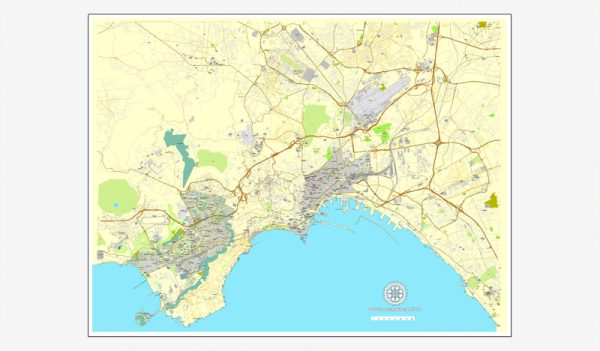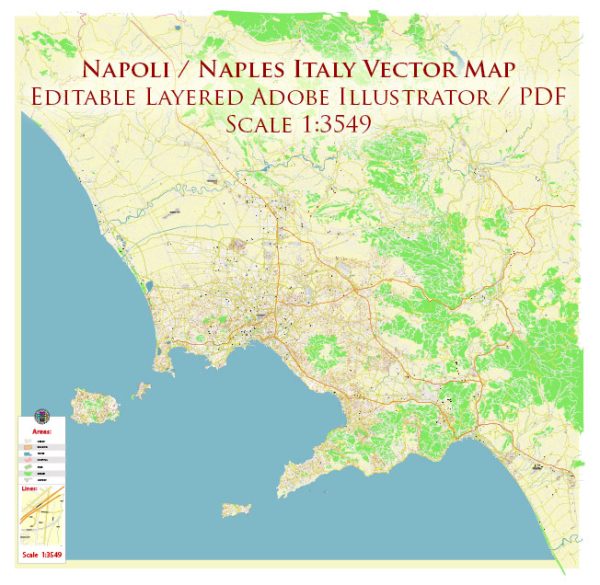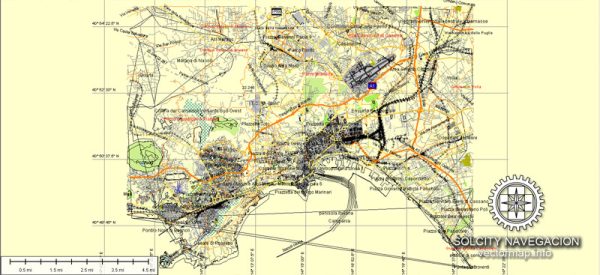Naples, Italy, is a city rich in history and diversity, reflected in its distinct districts, communities, and street system.
Vectormap.Net provide you with the most accurate and up-to-date vector maps in Adobe Illustrator, PDF and other formats, designed for editing and printing. Please read the vector map descriptions carefully.
Here’s a detailed description of these aspects:
Districts and Communities of Naples
Naples is divided into several districts and neighborhoods, each with its unique character and history. The city is organized into 10 municipalità (municipalities), which are further divided into smaller neighborhoods.
**1. Centro Storico (Historic Center)
- Overview: The historic center of Naples is a UNESCO World Heritage Site and one of the most densely packed areas of historical and cultural significance in the world. This district represents the ancient heart of Naples, where the city’s Greek and Roman roots are most evident.
- Key Areas:
- Spaccanapoli: This narrow street cuts straight through the historic center, representing the soul of old Naples. It is lined with historic churches, palaces, and traditional shops.
- Via dei Tribunali: Parallel to Spaccanapoli, this street is another ancient thoroughfare, known for its lively atmosphere, historic sites, and pizzerias.
- Significance: The Centro Storico is the beating heart of Naples, where history, religion, and everyday life intertwine in a vibrant, chaotic mix.
**2. Chiaia
- Overview: Chiaia is an upscale, elegant district located along the coast west of the historic center. It is known for its luxury boutiques, cafes, and a more refined atmosphere.
- Key Areas:
- Via Chiaia: The main shopping street, known for its high-end stores and stylish ambiance.
- Piazza dei Martiri: A central square surrounded by historic buildings and luxury shops.
- Significance: Chiaia is one of Naples’ most fashionable and affluent areas, offering a contrast to the historic center’s more chaotic vibe.
**3. Posillipo
- Overview: Posillipo is a picturesque residential district located on a hill overlooking the Bay of Naples. It is known for its stunning views, villas, and parks.
- Key Areas:
- Via Posillipo: The main road that winds through the district, offering breathtaking views of the sea and the city below.
- Parco Virgiliano: A beautiful park at the top of the hill, offering panoramic views of the Gulf of Naples, Mount Vesuvius, and the islands of Capri, Ischia, and Procida.
- Significance: Posillipo is a serene, scenic area favored by the Neapolitan elite and those seeking tranquility away from the bustling city center.
**4. Vomero
- Overview: Vomero is a hilly, residential district known for its middle-class vibe, tree-lined streets, and excellent shopping options. It’s located on a hill that offers sweeping views of Naples and the surrounding area.
- Key Areas:
- Via Scarlatti and Via Luca Giordano: These are the main shopping streets, offering a mix of boutiques, cafes, and chain stores.
- Castel Sant’Elmo: A medieval fortress that dominates the hill and offers spectacular views of the city and bay.
- Certosa di San Martino: A former monastery and museum located near Castel Sant’Elmo, with beautiful baroque architecture and art.
- Significance: Vomero is known for its more relaxed pace of life and is a popular residential area for families and professionals.
**5. Sanità
- Overview: The Sanità district is one of Naples’ most historic and culturally rich neighborhoods, located just north of the historic center. Despite its rich history, Sanità has been one of Naples’ poorest areas, though it is undergoing significant cultural and social revival.
- Key Areas:
- Via Sanità: The main street of the district, known for its vibrant markets and street life.
- Catacombs of San Gennaro: An extensive network of ancient catacombs located beneath the district, dating back to the 2nd century AD.
- Palazzo dello Spagnolo: A historic palace with a famous double staircase, representing the unique Baroque architecture of the area.
- Significance: Sanità is a neighborhood that embodies the resilience and spirit of Naples, with a rich cultural heritage that is being revitalized by local initiatives.
**6. Fuorigrotta
- Overview: Fuorigrotta is a large, modern residential and commercial district located west of the city center. It is known for its sports facilities, including the Stadio Diego Armando Maradona (formerly Stadio San Paolo).
- Key Areas:
- Stadio Diego Armando Maradona: The home stadium of SSC Napoli, the city’s beloved football team.
- Mostra d’Oltremare: A large exhibition center and park that hosts events, conferences, and cultural activities.
- Via Giulio Cesare: The main commercial street in the district, lined with shops, restaurants, and cafes.
- Significance: Fuorigrotta is a hub of modern life in Naples, known for its sports, entertainment, and residential developments.
**7. Bagnoli
- Overview: Bagnoli is a coastal district located west of Fuorigrotta, historically known for its industrial activity, particularly steel production. The area is undergoing redevelopment, with plans to transform it into a cultural and residential hub.
- Key Areas:
- Parco Urbano dei Camaldoli: A large urban park offering green spaces and recreational areas.
- Città della Scienza: A science museum and educational center located along the coast, part of the broader redevelopment of the area.
- Via di Pozzuoli: The main street connecting Bagnoli with the nearby town of Pozzuoli.
- Significance: Bagnoli represents the ongoing transformation of Naples from an industrial past to a future focused on culture, education, and green living.
Main Streets of Naples
**1. Spaccanapoli
- Description: Spaccanapoli is the most famous street in Naples, running straight through the historic center. The street’s name means “Naples splitter,” as it divides the old town into two parts.
- Significance: It is lined with historic churches, palaces, and traditional shops, making it a must-visit for anyone interested in the city’s rich history and vibrant street life.
**2. Via Toledo
- Description: Via Toledo is a major shopping street that runs from Piazza Dante to Piazza Trieste e Trento near the Royal Palace.
- Significance: This bustling street is known for its mix of high-end stores, cafes, and historic buildings. It is a central artery of Naples’ commercial life.
**3. Via Chiaia
- Description: Via Chiaia is a stylish street in the Chiaia district, running from Piazza Trieste e Trento to Piazza dei Martiri.
- Significance: Known for its luxury boutiques and elegant atmosphere, Via Chiaia is one of the most fashionable streets in Naples.
**4. Via San Gregorio Armeno
- Description: This narrow street in the historic center is famous for its artisan workshops specializing in presepi (Nativity scenes).
- Significance: Via San Gregorio Armeno is a unique street where traditional crafts have been practiced for centuries, especially during the Christmas season.
**5. Corso Umberto I (Rettifilo)
- Description: Corso Umberto I, commonly known as Rettifilo, is a major thoroughfare that connects the central station area (Piazza Garibaldi) with the historic center.
- Significance: It is a busy commercial street with a mix of shops, offices, and educational institutions, representing the modern face of Naples.
**6. Via Partenope
- Description: Via Partenope is a scenic coastal road that runs along the seafront, offering stunning views of the Bay of Naples, Castel dell’Ovo, and Mount Vesuvius.
- Significance: This street is a popular spot for leisurely strolls, with numerous cafes and restaurants offering seaside dining.
Summary
Naples is a city of contrasts, with districts ranging from the ancient and chaotic streets of the Centro Storico to the elegant boulevards of Chiaia and the scenic, tranquil hills of Posillipo. Each district and street tells a part of the city’s complex history, from its Greek and Roman origins to its modern-day vibrancy. Whether you’re exploring the narrow alleys of Spaccanapoli, shopping on Via Toledo, or enjoying the views along Via Partenope, Naples offers a rich and varied urban experience.




 Author: Kirill Shrayber, Ph.D.
Author: Kirill Shrayber, Ph.D.